Strategic International Business Management Report: Lidl's Expansion
VerifiedAdded on 2022/08/18
|22
|5198
|9
Report
AI Summary
This report examines Lidl's strategic international expansion, focusing on Mexico and Norway as potential target markets. It begins with a comparative PESTLE analysis to assess the macro-environmental factors of both countries, identifying Mexico as the more suitable choice. The report then applies Porter's Five Forces model to analyze the competitive intensity of the Mexican discount retail industry. An internal environment analysis of Lidl using the VRIO framework is performed, suggesting a competitive advantage in Mexico. Finally, the report evaluates various foreign market entry modes, recommending franchising as the most appropriate option for Lidl's successful entry into the Mexican market. The report provides a comprehensive overview of the strategic considerations for Lidl's global expansion.
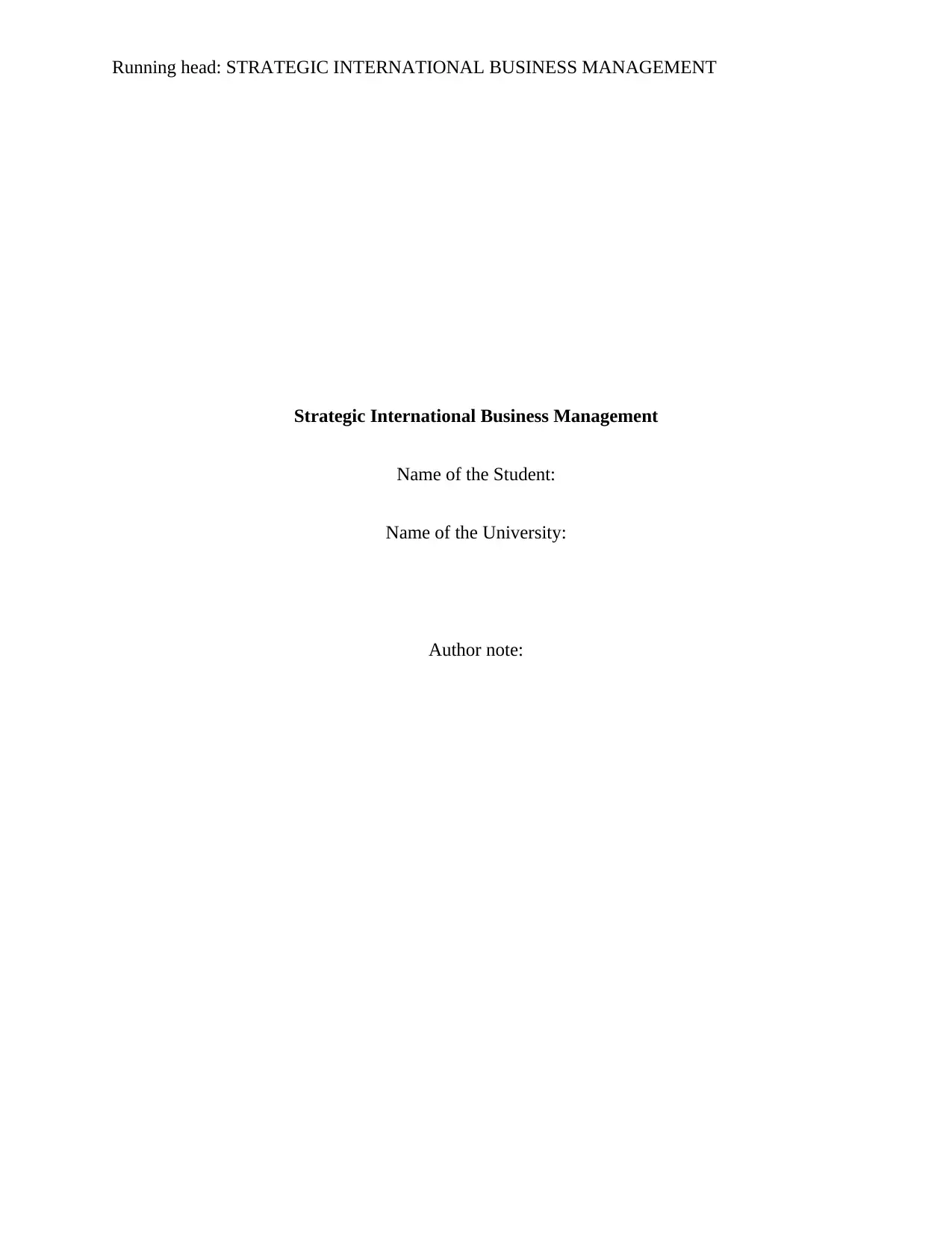
Running head: STRATEGIC INTERNATIONAL BUSINESS MANAGEMENT
Strategic International Business Management
Name of the Student:
Name of the University:
Author note:
Strategic International Business Management
Name of the Student:
Name of the University:
Author note:
Paraphrase This Document
Need a fresh take? Get an instant paraphrase of this document with our AI Paraphraser
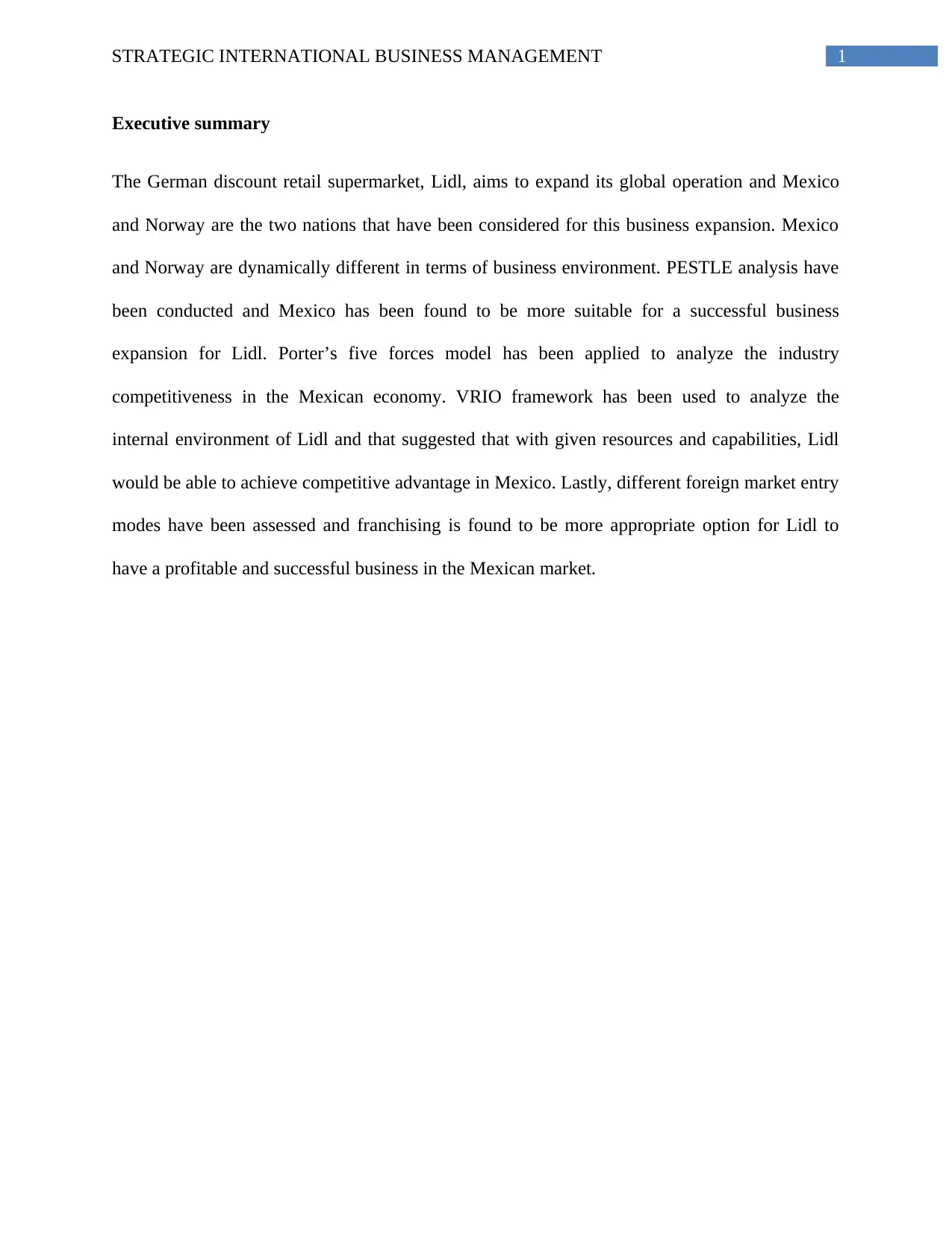
1STRATEGIC INTERNATIONAL BUSINESS MANAGEMENT
Executive summary
The German discount retail supermarket, Lidl, aims to expand its global operation and Mexico
and Norway are the two nations that have been considered for this business expansion. Mexico
and Norway are dynamically different in terms of business environment. PESTLE analysis have
been conducted and Mexico has been found to be more suitable for a successful business
expansion for Lidl. Porter’s five forces model has been applied to analyze the industry
competitiveness in the Mexican economy. VRIO framework has been used to analyze the
internal environment of Lidl and that suggested that with given resources and capabilities, Lidl
would be able to achieve competitive advantage in Mexico. Lastly, different foreign market entry
modes have been assessed and franchising is found to be more appropriate option for Lidl to
have a profitable and successful business in the Mexican market.
Executive summary
The German discount retail supermarket, Lidl, aims to expand its global operation and Mexico
and Norway are the two nations that have been considered for this business expansion. Mexico
and Norway are dynamically different in terms of business environment. PESTLE analysis have
been conducted and Mexico has been found to be more suitable for a successful business
expansion for Lidl. Porter’s five forces model has been applied to analyze the industry
competitiveness in the Mexican economy. VRIO framework has been used to analyze the
internal environment of Lidl and that suggested that with given resources and capabilities, Lidl
would be able to achieve competitive advantage in Mexico. Lastly, different foreign market entry
modes have been assessed and franchising is found to be more appropriate option for Lidl to
have a profitable and successful business in the Mexican market.
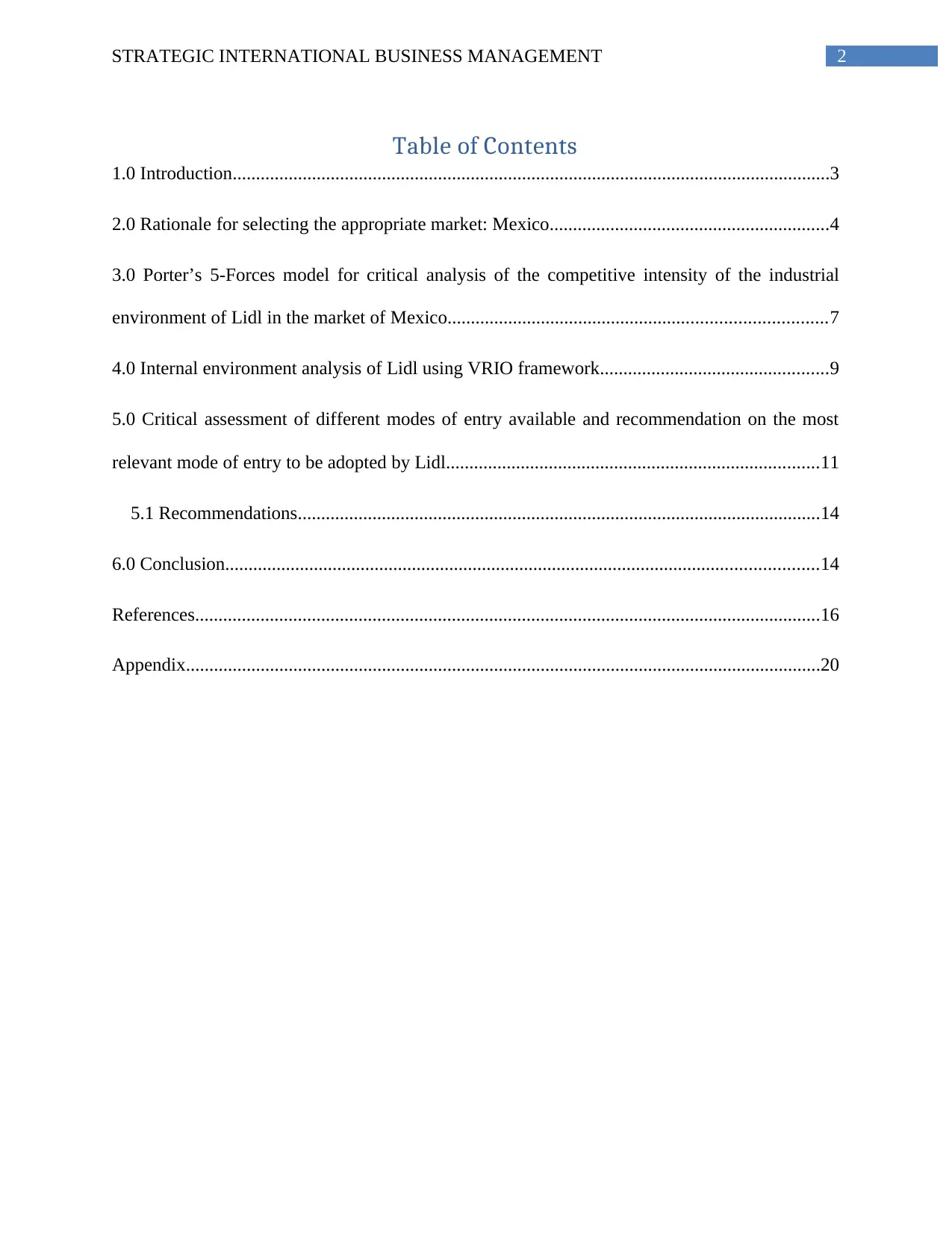
2STRATEGIC INTERNATIONAL BUSINESS MANAGEMENT
Table of Contents
1.0 Introduction................................................................................................................................3
2.0 Rationale for selecting the appropriate market: Mexico............................................................4
3.0 Porter’s 5-Forces model for critical analysis of the competitive intensity of the industrial
environment of Lidl in the market of Mexico.................................................................................7
4.0 Internal environment analysis of Lidl using VRIO framework.................................................9
5.0 Critical assessment of different modes of entry available and recommendation on the most
relevant mode of entry to be adopted by Lidl................................................................................11
5.1 Recommendations................................................................................................................14
6.0 Conclusion...............................................................................................................................14
References......................................................................................................................................16
Appendix........................................................................................................................................20
Table of Contents
1.0 Introduction................................................................................................................................3
2.0 Rationale for selecting the appropriate market: Mexico............................................................4
3.0 Porter’s 5-Forces model for critical analysis of the competitive intensity of the industrial
environment of Lidl in the market of Mexico.................................................................................7
4.0 Internal environment analysis of Lidl using VRIO framework.................................................9
5.0 Critical assessment of different modes of entry available and recommendation on the most
relevant mode of entry to be adopted by Lidl................................................................................11
5.1 Recommendations................................................................................................................14
6.0 Conclusion...............................................................................................................................14
References......................................................................................................................................16
Appendix........................................................................................................................................20
⊘ This is a preview!⊘
Do you want full access?
Subscribe today to unlock all pages.

Trusted by 1+ million students worldwide
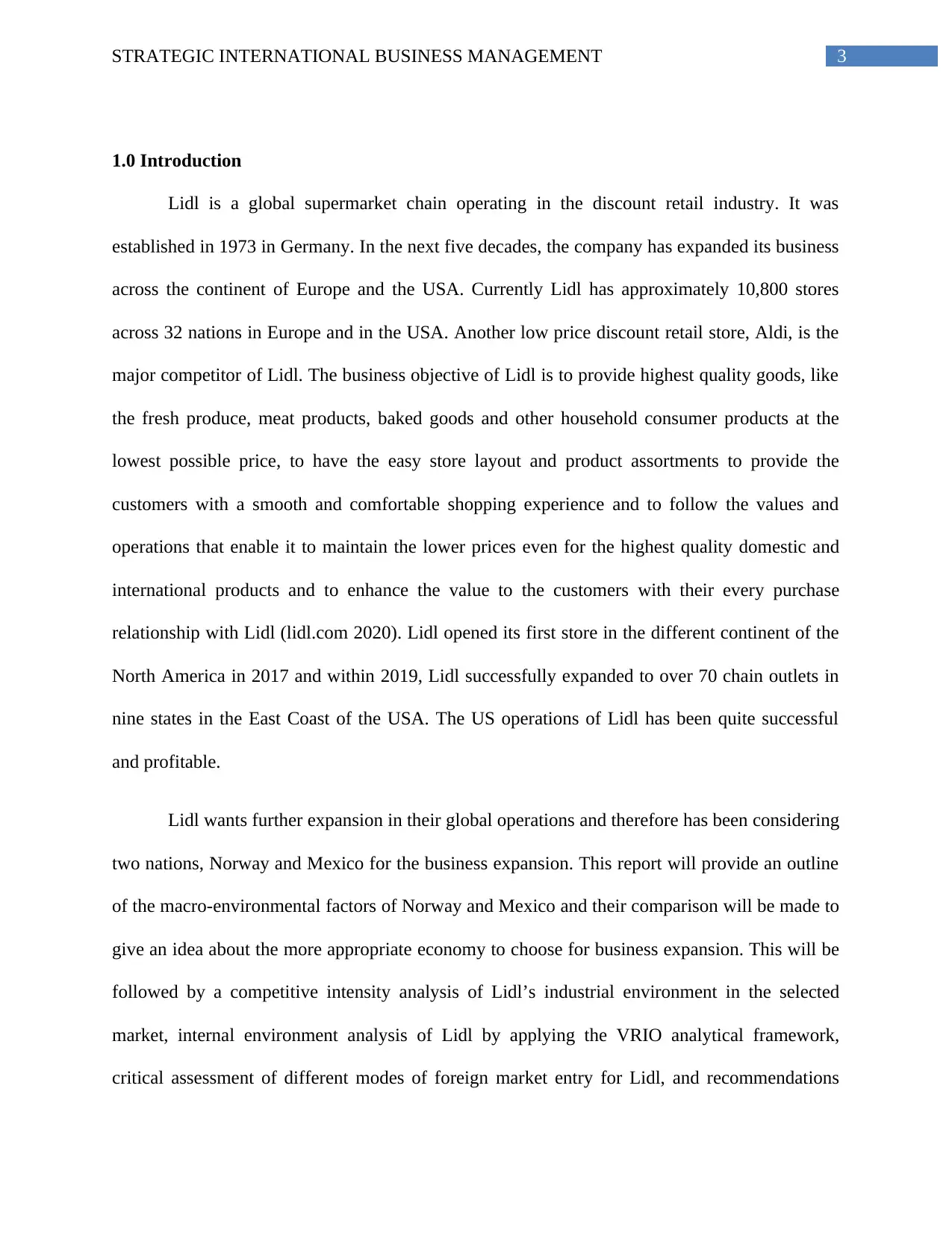
3STRATEGIC INTERNATIONAL BUSINESS MANAGEMENT
1.0 Introduction
Lidl is a global supermarket chain operating in the discount retail industry. It was
established in 1973 in Germany. In the next five decades, the company has expanded its business
across the continent of Europe and the USA. Currently Lidl has approximately 10,800 stores
across 32 nations in Europe and in the USA. Another low price discount retail store, Aldi, is the
major competitor of Lidl. The business objective of Lidl is to provide highest quality goods, like
the fresh produce, meat products, baked goods and other household consumer products at the
lowest possible price, to have the easy store layout and product assortments to provide the
customers with a smooth and comfortable shopping experience and to follow the values and
operations that enable it to maintain the lower prices even for the highest quality domestic and
international products and to enhance the value to the customers with their every purchase
relationship with Lidl (lidl.com 2020). Lidl opened its first store in the different continent of the
North America in 2017 and within 2019, Lidl successfully expanded to over 70 chain outlets in
nine states in the East Coast of the USA. The US operations of Lidl has been quite successful
and profitable.
Lidl wants further expansion in their global operations and therefore has been considering
two nations, Norway and Mexico for the business expansion. This report will provide an outline
of the macro-environmental factors of Norway and Mexico and their comparison will be made to
give an idea about the more appropriate economy to choose for business expansion. This will be
followed by a competitive intensity analysis of Lidl’s industrial environment in the selected
market, internal environment analysis of Lidl by applying the VRIO analytical framework,
critical assessment of different modes of foreign market entry for Lidl, and recommendations
1.0 Introduction
Lidl is a global supermarket chain operating in the discount retail industry. It was
established in 1973 in Germany. In the next five decades, the company has expanded its business
across the continent of Europe and the USA. Currently Lidl has approximately 10,800 stores
across 32 nations in Europe and in the USA. Another low price discount retail store, Aldi, is the
major competitor of Lidl. The business objective of Lidl is to provide highest quality goods, like
the fresh produce, meat products, baked goods and other household consumer products at the
lowest possible price, to have the easy store layout and product assortments to provide the
customers with a smooth and comfortable shopping experience and to follow the values and
operations that enable it to maintain the lower prices even for the highest quality domestic and
international products and to enhance the value to the customers with their every purchase
relationship with Lidl (lidl.com 2020). Lidl opened its first store in the different continent of the
North America in 2017 and within 2019, Lidl successfully expanded to over 70 chain outlets in
nine states in the East Coast of the USA. The US operations of Lidl has been quite successful
and profitable.
Lidl wants further expansion in their global operations and therefore has been considering
two nations, Norway and Mexico for the business expansion. This report will provide an outline
of the macro-environmental factors of Norway and Mexico and their comparison will be made to
give an idea about the more appropriate economy to choose for business expansion. This will be
followed by a competitive intensity analysis of Lidl’s industrial environment in the selected
market, internal environment analysis of Lidl by applying the VRIO analytical framework,
critical assessment of different modes of foreign market entry for Lidl, and recommendations
Paraphrase This Document
Need a fresh take? Get an instant paraphrase of this document with our AI Paraphraser
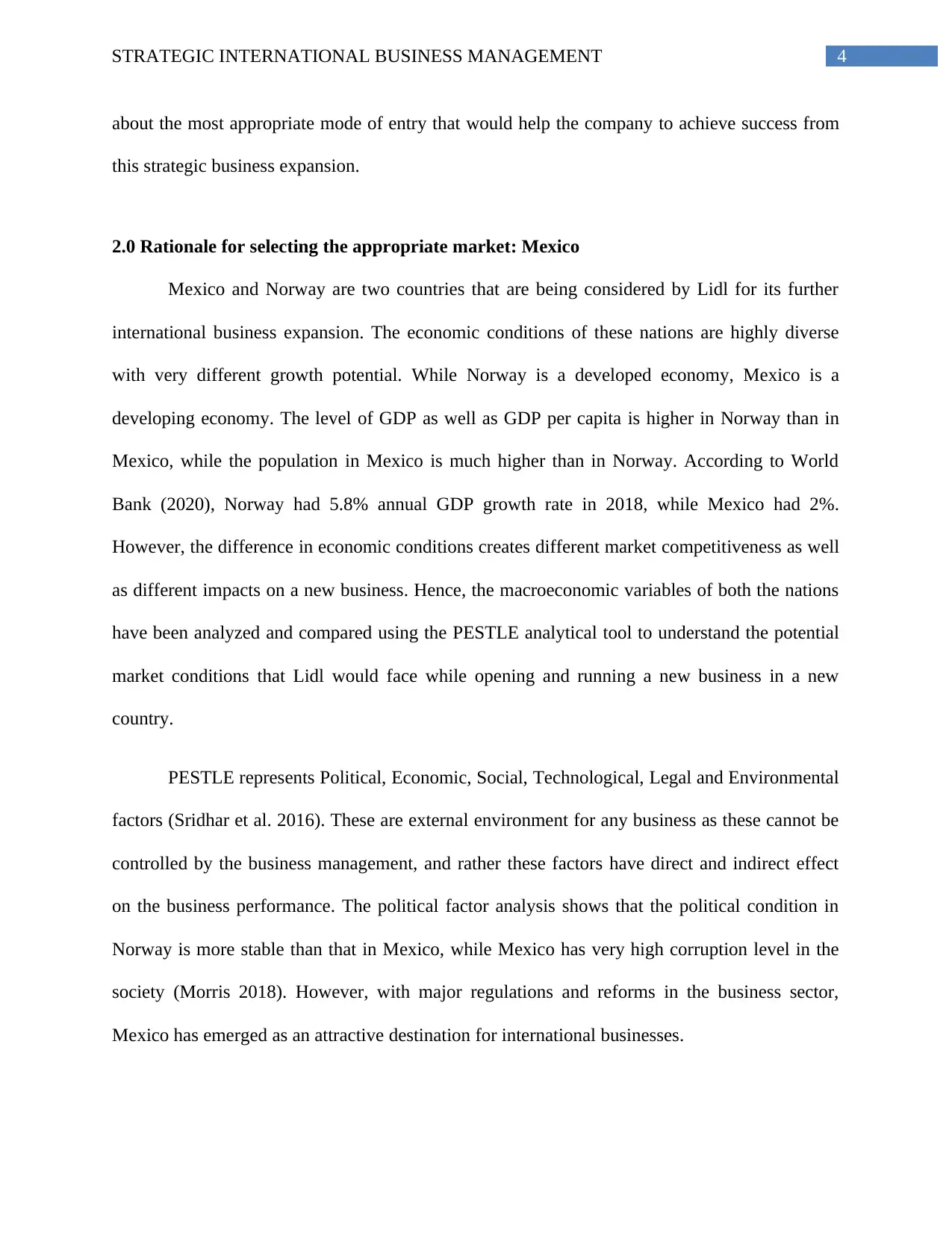
4STRATEGIC INTERNATIONAL BUSINESS MANAGEMENT
about the most appropriate mode of entry that would help the company to achieve success from
this strategic business expansion.
2.0 Rationale for selecting the appropriate market: Mexico
Mexico and Norway are two countries that are being considered by Lidl for its further
international business expansion. The economic conditions of these nations are highly diverse
with very different growth potential. While Norway is a developed economy, Mexico is a
developing economy. The level of GDP as well as GDP per capita is higher in Norway than in
Mexico, while the population in Mexico is much higher than in Norway. According to World
Bank (2020), Norway had 5.8% annual GDP growth rate in 2018, while Mexico had 2%.
However, the difference in economic conditions creates different market competitiveness as well
as different impacts on a new business. Hence, the macroeconomic variables of both the nations
have been analyzed and compared using the PESTLE analytical tool to understand the potential
market conditions that Lidl would face while opening and running a new business in a new
country.
PESTLE represents Political, Economic, Social, Technological, Legal and Environmental
factors (Sridhar et al. 2016). These are external environment for any business as these cannot be
controlled by the business management, and rather these factors have direct and indirect effect
on the business performance. The political factor analysis shows that the political condition in
Norway is more stable than that in Mexico, while Mexico has very high corruption level in the
society (Morris 2018). However, with major regulations and reforms in the business sector,
Mexico has emerged as an attractive destination for international businesses.
about the most appropriate mode of entry that would help the company to achieve success from
this strategic business expansion.
2.0 Rationale for selecting the appropriate market: Mexico
Mexico and Norway are two countries that are being considered by Lidl for its further
international business expansion. The economic conditions of these nations are highly diverse
with very different growth potential. While Norway is a developed economy, Mexico is a
developing economy. The level of GDP as well as GDP per capita is higher in Norway than in
Mexico, while the population in Mexico is much higher than in Norway. According to World
Bank (2020), Norway had 5.8% annual GDP growth rate in 2018, while Mexico had 2%.
However, the difference in economic conditions creates different market competitiveness as well
as different impacts on a new business. Hence, the macroeconomic variables of both the nations
have been analyzed and compared using the PESTLE analytical tool to understand the potential
market conditions that Lidl would face while opening and running a new business in a new
country.
PESTLE represents Political, Economic, Social, Technological, Legal and Environmental
factors (Sridhar et al. 2016). These are external environment for any business as these cannot be
controlled by the business management, and rather these factors have direct and indirect effect
on the business performance. The political factor analysis shows that the political condition in
Norway is more stable than that in Mexico, while Mexico has very high corruption level in the
society (Morris 2018). However, with major regulations and reforms in the business sector,
Mexico has emerged as an attractive destination for international businesses.
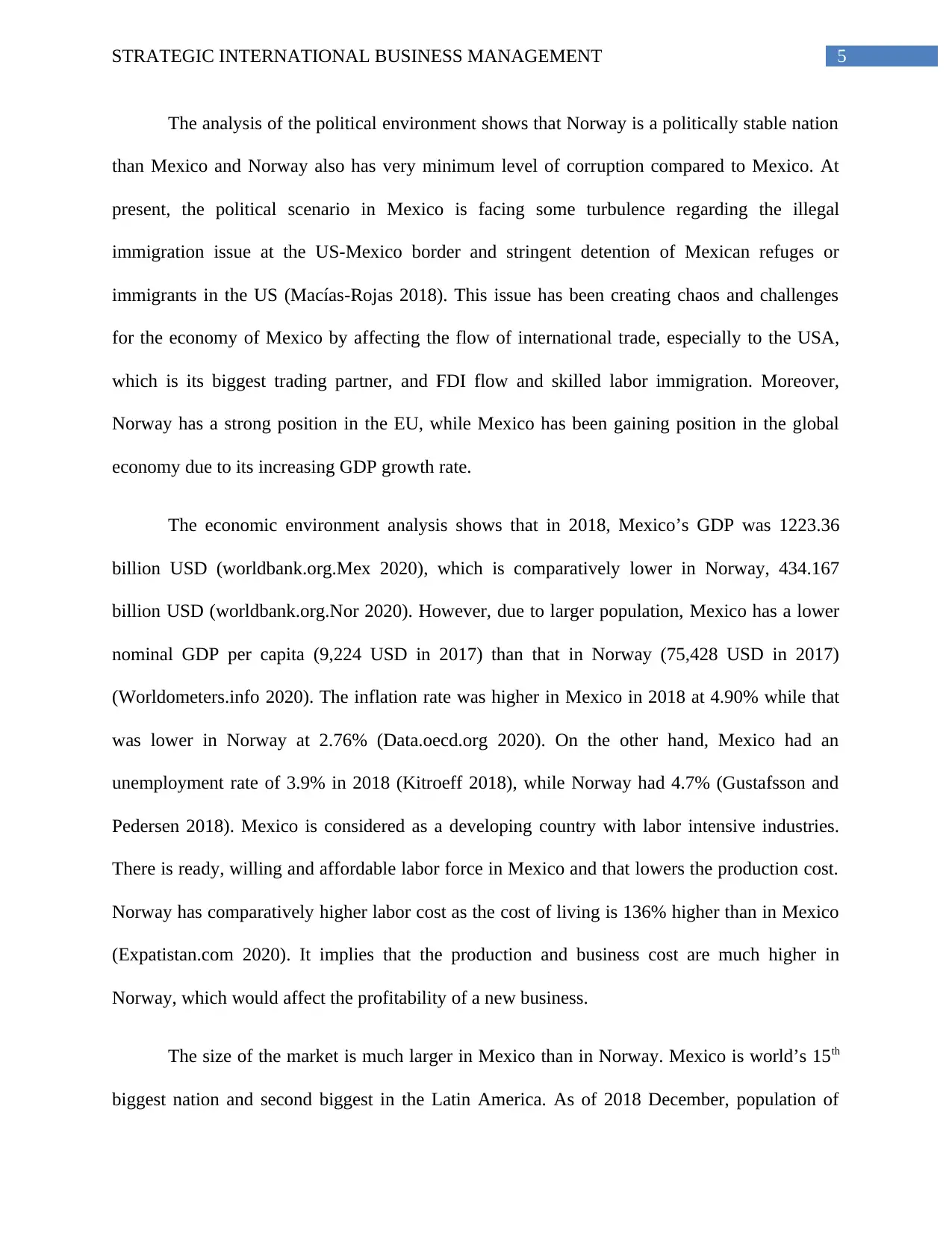
5STRATEGIC INTERNATIONAL BUSINESS MANAGEMENT
The analysis of the political environment shows that Norway is a politically stable nation
than Mexico and Norway also has very minimum level of corruption compared to Mexico. At
present, the political scenario in Mexico is facing some turbulence regarding the illegal
immigration issue at the US-Mexico border and stringent detention of Mexican refuges or
immigrants in the US (Macías-Rojas 2018). This issue has been creating chaos and challenges
for the economy of Mexico by affecting the flow of international trade, especially to the USA,
which is its biggest trading partner, and FDI flow and skilled labor immigration. Moreover,
Norway has a strong position in the EU, while Mexico has been gaining position in the global
economy due to its increasing GDP growth rate.
The economic environment analysis shows that in 2018, Mexico’s GDP was 1223.36
billion USD (worldbank.org.Mex 2020), which is comparatively lower in Norway, 434.167
billion USD (worldbank.org.Nor 2020). However, due to larger population, Mexico has a lower
nominal GDP per capita (9,224 USD in 2017) than that in Norway (75,428 USD in 2017)
(Worldometers.info 2020). The inflation rate was higher in Mexico in 2018 at 4.90% while that
was lower in Norway at 2.76% (Data.oecd.org 2020). On the other hand, Mexico had an
unemployment rate of 3.9% in 2018 (Kitroeff 2018), while Norway had 4.7% (Gustafsson and
Pedersen 2018). Mexico is considered as a developing country with labor intensive industries.
There is ready, willing and affordable labor force in Mexico and that lowers the production cost.
Norway has comparatively higher labor cost as the cost of living is 136% higher than in Mexico
(Expatistan.com 2020). It implies that the production and business cost are much higher in
Norway, which would affect the profitability of a new business.
The size of the market is much larger in Mexico than in Norway. Mexico is world’s 15th
biggest nation and second biggest in the Latin America. As of 2018 December, population of
The analysis of the political environment shows that Norway is a politically stable nation
than Mexico and Norway also has very minimum level of corruption compared to Mexico. At
present, the political scenario in Mexico is facing some turbulence regarding the illegal
immigration issue at the US-Mexico border and stringent detention of Mexican refuges or
immigrants in the US (Macías-Rojas 2018). This issue has been creating chaos and challenges
for the economy of Mexico by affecting the flow of international trade, especially to the USA,
which is its biggest trading partner, and FDI flow and skilled labor immigration. Moreover,
Norway has a strong position in the EU, while Mexico has been gaining position in the global
economy due to its increasing GDP growth rate.
The economic environment analysis shows that in 2018, Mexico’s GDP was 1223.36
billion USD (worldbank.org.Mex 2020), which is comparatively lower in Norway, 434.167
billion USD (worldbank.org.Nor 2020). However, due to larger population, Mexico has a lower
nominal GDP per capita (9,224 USD in 2017) than that in Norway (75,428 USD in 2017)
(Worldometers.info 2020). The inflation rate was higher in Mexico in 2018 at 4.90% while that
was lower in Norway at 2.76% (Data.oecd.org 2020). On the other hand, Mexico had an
unemployment rate of 3.9% in 2018 (Kitroeff 2018), while Norway had 4.7% (Gustafsson and
Pedersen 2018). Mexico is considered as a developing country with labor intensive industries.
There is ready, willing and affordable labor force in Mexico and that lowers the production cost.
Norway has comparatively higher labor cost as the cost of living is 136% higher than in Mexico
(Expatistan.com 2020). It implies that the production and business cost are much higher in
Norway, which would affect the profitability of a new business.
The size of the market is much larger in Mexico than in Norway. Mexico is world’s 15th
biggest nation and second biggest in the Latin America. As of 2018 December, population of
⊘ This is a preview!⊘
Do you want full access?
Subscribe today to unlock all pages.

Trusted by 1+ million students worldwide
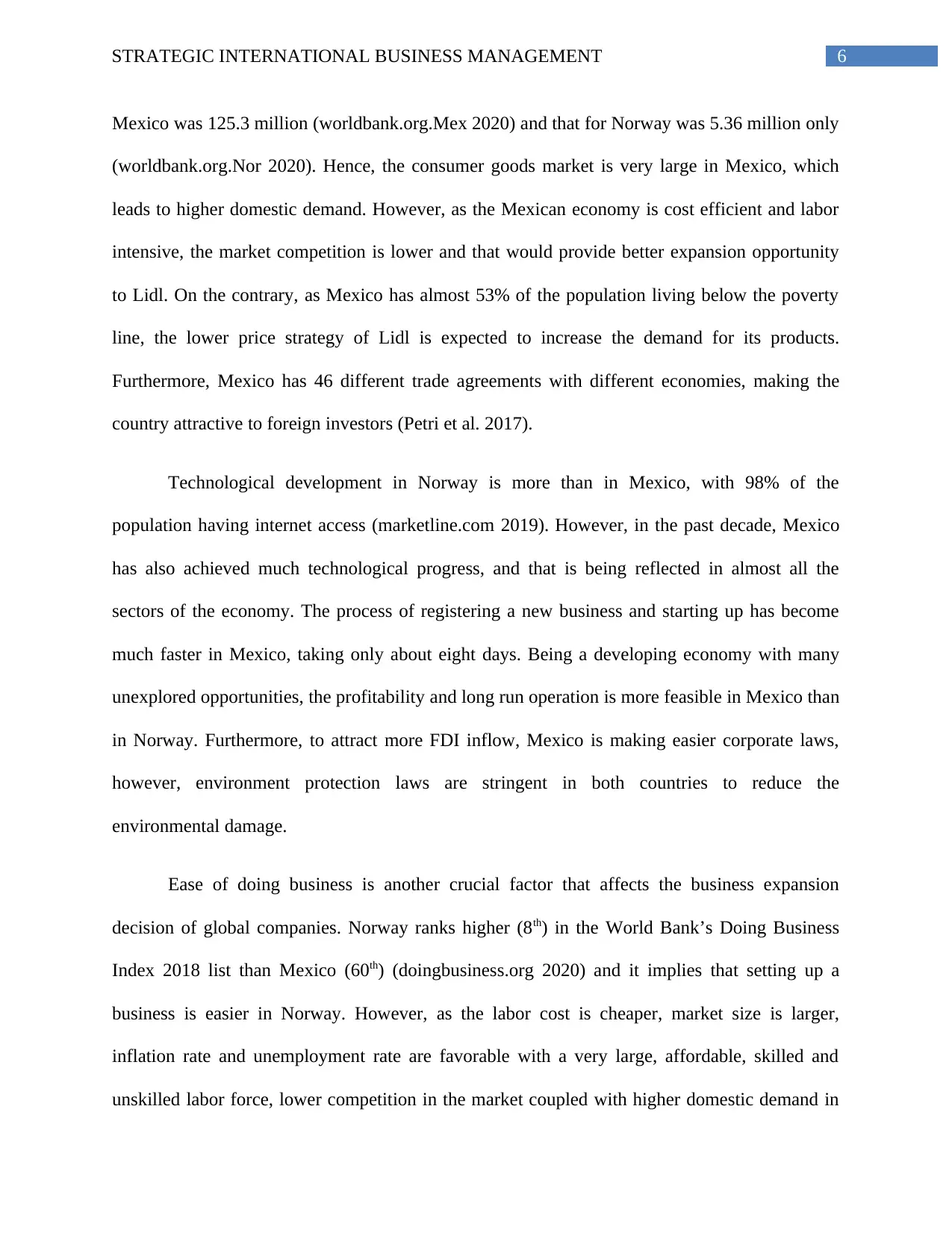
6STRATEGIC INTERNATIONAL BUSINESS MANAGEMENT
Mexico was 125.3 million (worldbank.org.Mex 2020) and that for Norway was 5.36 million only
(worldbank.org.Nor 2020). Hence, the consumer goods market is very large in Mexico, which
leads to higher domestic demand. However, as the Mexican economy is cost efficient and labor
intensive, the market competition is lower and that would provide better expansion opportunity
to Lidl. On the contrary, as Mexico has almost 53% of the population living below the poverty
line, the lower price strategy of Lidl is expected to increase the demand for its products.
Furthermore, Mexico has 46 different trade agreements with different economies, making the
country attractive to foreign investors (Petri et al. 2017).
Technological development in Norway is more than in Mexico, with 98% of the
population having internet access (marketline.com 2019). However, in the past decade, Mexico
has also achieved much technological progress, and that is being reflected in almost all the
sectors of the economy. The process of registering a new business and starting up has become
much faster in Mexico, taking only about eight days. Being a developing economy with many
unexplored opportunities, the profitability and long run operation is more feasible in Mexico than
in Norway. Furthermore, to attract more FDI inflow, Mexico is making easier corporate laws,
however, environment protection laws are stringent in both countries to reduce the
environmental damage.
Ease of doing business is another crucial factor that affects the business expansion
decision of global companies. Norway ranks higher (8th) in the World Bank’s Doing Business
Index 2018 list than Mexico (60th) (doingbusiness.org 2020) and it implies that setting up a
business is easier in Norway. However, as the labor cost is cheaper, market size is larger,
inflation rate and unemployment rate are favorable with a very large, affordable, skilled and
unskilled labor force, lower competition in the market coupled with higher domestic demand in
Mexico was 125.3 million (worldbank.org.Mex 2020) and that for Norway was 5.36 million only
(worldbank.org.Nor 2020). Hence, the consumer goods market is very large in Mexico, which
leads to higher domestic demand. However, as the Mexican economy is cost efficient and labor
intensive, the market competition is lower and that would provide better expansion opportunity
to Lidl. On the contrary, as Mexico has almost 53% of the population living below the poverty
line, the lower price strategy of Lidl is expected to increase the demand for its products.
Furthermore, Mexico has 46 different trade agreements with different economies, making the
country attractive to foreign investors (Petri et al. 2017).
Technological development in Norway is more than in Mexico, with 98% of the
population having internet access (marketline.com 2019). However, in the past decade, Mexico
has also achieved much technological progress, and that is being reflected in almost all the
sectors of the economy. The process of registering a new business and starting up has become
much faster in Mexico, taking only about eight days. Being a developing economy with many
unexplored opportunities, the profitability and long run operation is more feasible in Mexico than
in Norway. Furthermore, to attract more FDI inflow, Mexico is making easier corporate laws,
however, environment protection laws are stringent in both countries to reduce the
environmental damage.
Ease of doing business is another crucial factor that affects the business expansion
decision of global companies. Norway ranks higher (8th) in the World Bank’s Doing Business
Index 2018 list than Mexico (60th) (doingbusiness.org 2020) and it implies that setting up a
business is easier in Norway. However, as the labor cost is cheaper, market size is larger,
inflation rate and unemployment rate are favorable with a very large, affordable, skilled and
unskilled labor force, lower competition in the market coupled with higher domestic demand in
Paraphrase This Document
Need a fresh take? Get an instant paraphrase of this document with our AI Paraphraser
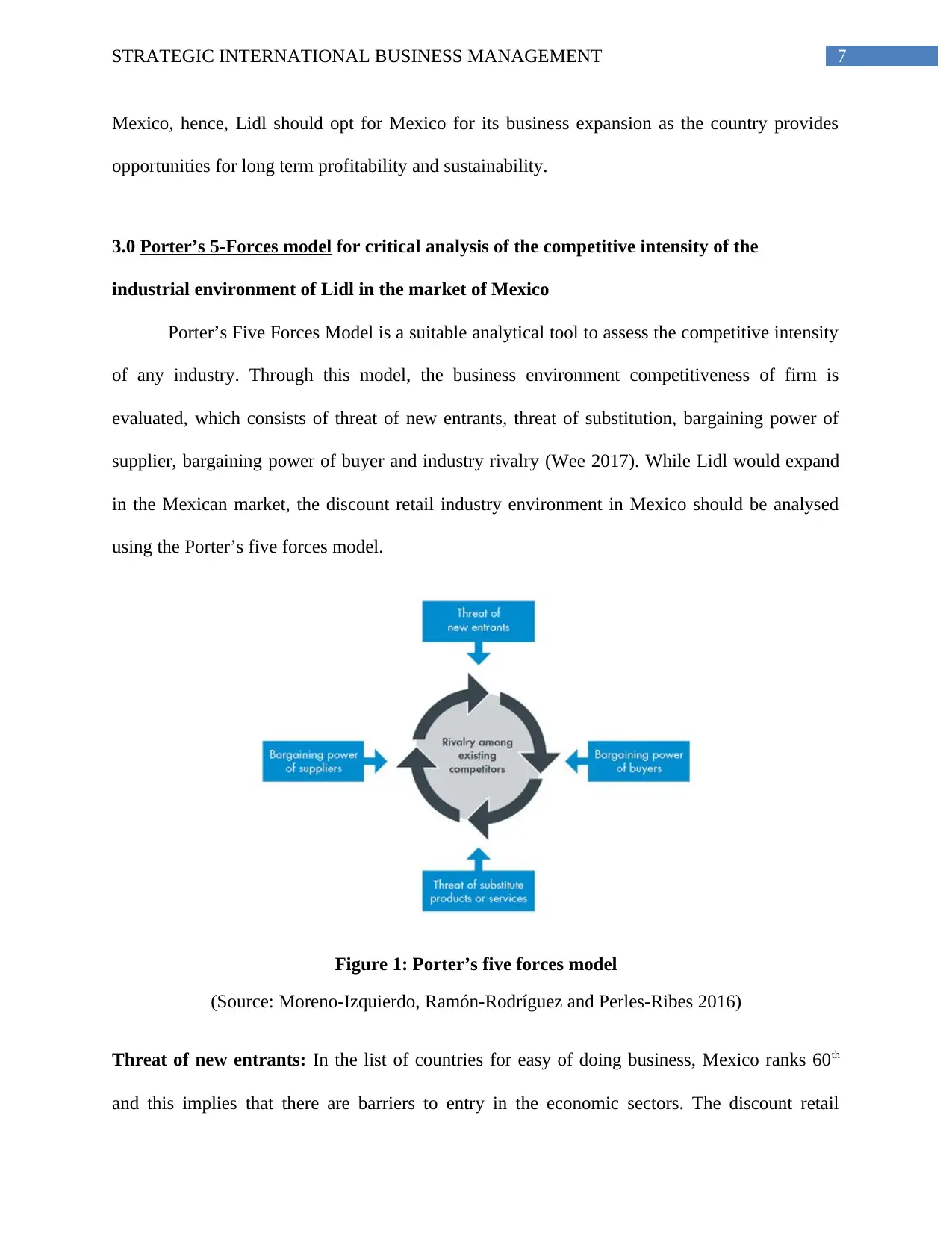
7STRATEGIC INTERNATIONAL BUSINESS MANAGEMENT
Mexico, hence, Lidl should opt for Mexico for its business expansion as the country provides
opportunities for long term profitability and sustainability.
3.0 Porter’s 5-Forces model for critical analysis of the competitive intensity of the
industrial environment of Lidl in the market of Mexico
Porter’s Five Forces Model is a suitable analytical tool to assess the competitive intensity
of any industry. Through this model, the business environment competitiveness of firm is
evaluated, which consists of threat of new entrants, threat of substitution, bargaining power of
supplier, bargaining power of buyer and industry rivalry (Wee 2017). While Lidl would expand
in the Mexican market, the discount retail industry environment in Mexico should be analysed
using the Porter’s five forces model.
Figure 1: Porter’s five forces model
(Source: Moreno-Izquierdo, Ramón-Rodríguez and Perles-Ribes 2016)
Threat of new entrants: In the list of countries for easy of doing business, Mexico ranks 60th
and this implies that there are barriers to entry in the economic sectors. The discount retail
Mexico, hence, Lidl should opt for Mexico for its business expansion as the country provides
opportunities for long term profitability and sustainability.
3.0 Porter’s 5-Forces model for critical analysis of the competitive intensity of the
industrial environment of Lidl in the market of Mexico
Porter’s Five Forces Model is a suitable analytical tool to assess the competitive intensity
of any industry. Through this model, the business environment competitiveness of firm is
evaluated, which consists of threat of new entrants, threat of substitution, bargaining power of
supplier, bargaining power of buyer and industry rivalry (Wee 2017). While Lidl would expand
in the Mexican market, the discount retail industry environment in Mexico should be analysed
using the Porter’s five forces model.
Figure 1: Porter’s five forces model
(Source: Moreno-Izquierdo, Ramón-Rodríguez and Perles-Ribes 2016)
Threat of new entrants: In the list of countries for easy of doing business, Mexico ranks 60th
and this implies that there are barriers to entry in the economic sectors. The discount retail
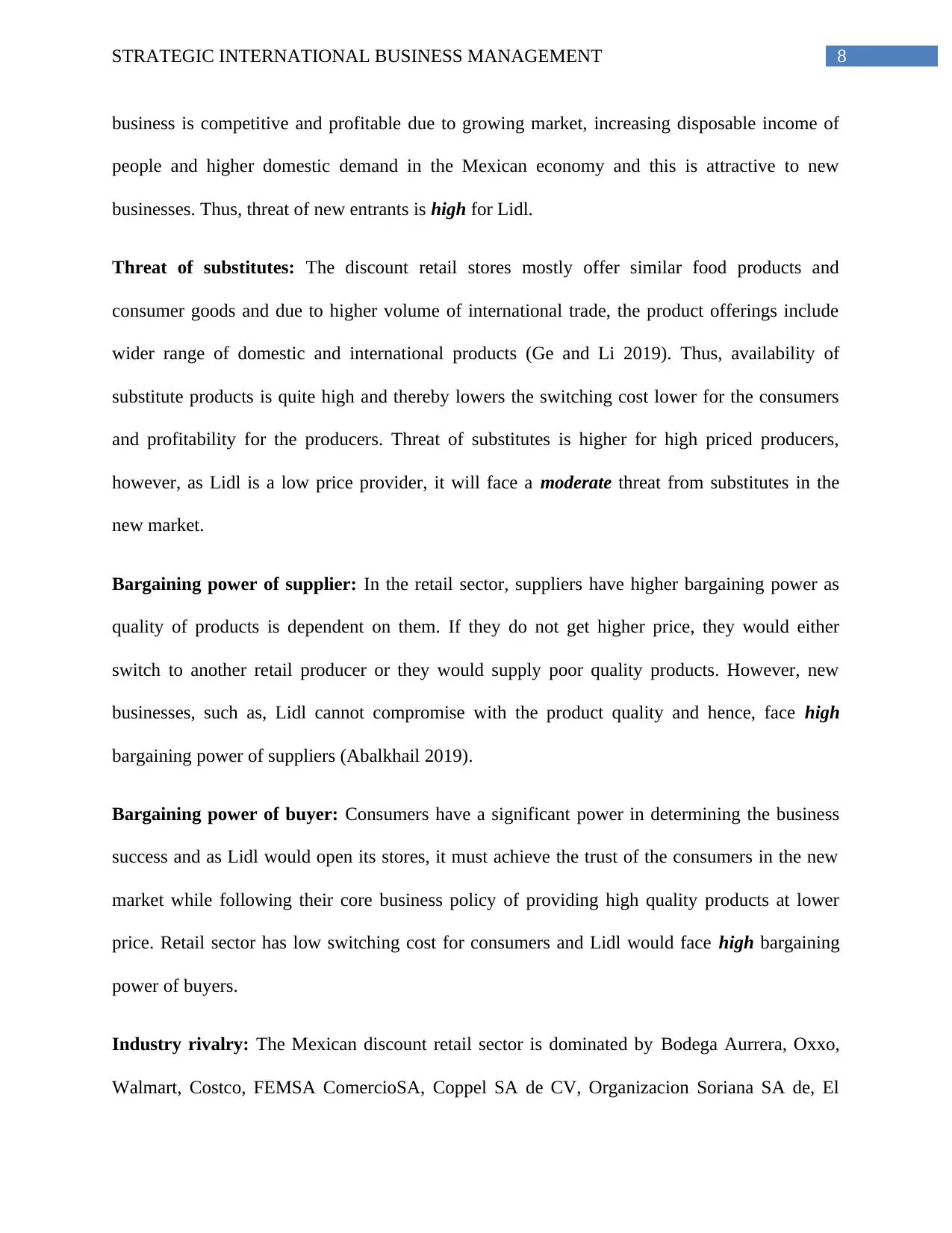
8STRATEGIC INTERNATIONAL BUSINESS MANAGEMENT
business is competitive and profitable due to growing market, increasing disposable income of
people and higher domestic demand in the Mexican economy and this is attractive to new
businesses. Thus, threat of new entrants is high for Lidl.
Threat of substitutes: The discount retail stores mostly offer similar food products and
consumer goods and due to higher volume of international trade, the product offerings include
wider range of domestic and international products (Ge and Li 2019). Thus, availability of
substitute products is quite high and thereby lowers the switching cost lower for the consumers
and profitability for the producers. Threat of substitutes is higher for high priced producers,
however, as Lidl is a low price provider, it will face a moderate threat from substitutes in the
new market.
Bargaining power of supplier: In the retail sector, suppliers have higher bargaining power as
quality of products is dependent on them. If they do not get higher price, they would either
switch to another retail producer or they would supply poor quality products. However, new
businesses, such as, Lidl cannot compromise with the product quality and hence, face high
bargaining power of suppliers (Abalkhail 2019).
Bargaining power of buyer: Consumers have a significant power in determining the business
success and as Lidl would open its stores, it must achieve the trust of the consumers in the new
market while following their core business policy of providing high quality products at lower
price. Retail sector has low switching cost for consumers and Lidl would face high bargaining
power of buyers.
Industry rivalry: The Mexican discount retail sector is dominated by Bodega Aurrera, Oxxo,
Walmart, Costco, FEMSA ComercioSA, Coppel SA de CV, Organizacion Soriana SA de, El
business is competitive and profitable due to growing market, increasing disposable income of
people and higher domestic demand in the Mexican economy and this is attractive to new
businesses. Thus, threat of new entrants is high for Lidl.
Threat of substitutes: The discount retail stores mostly offer similar food products and
consumer goods and due to higher volume of international trade, the product offerings include
wider range of domestic and international products (Ge and Li 2019). Thus, availability of
substitute products is quite high and thereby lowers the switching cost lower for the consumers
and profitability for the producers. Threat of substitutes is higher for high priced producers,
however, as Lidl is a low price provider, it will face a moderate threat from substitutes in the
new market.
Bargaining power of supplier: In the retail sector, suppliers have higher bargaining power as
quality of products is dependent on them. If they do not get higher price, they would either
switch to another retail producer or they would supply poor quality products. However, new
businesses, such as, Lidl cannot compromise with the product quality and hence, face high
bargaining power of suppliers (Abalkhail 2019).
Bargaining power of buyer: Consumers have a significant power in determining the business
success and as Lidl would open its stores, it must achieve the trust of the consumers in the new
market while following their core business policy of providing high quality products at lower
price. Retail sector has low switching cost for consumers and Lidl would face high bargaining
power of buyers.
Industry rivalry: The Mexican discount retail sector is dominated by Bodega Aurrera, Oxxo,
Walmart, Costco, FEMSA ComercioSA, Coppel SA de CV, Organizacion Soriana SA de, El
⊘ This is a preview!⊘
Do you want full access?
Subscribe today to unlock all pages.

Trusted by 1+ million students worldwide
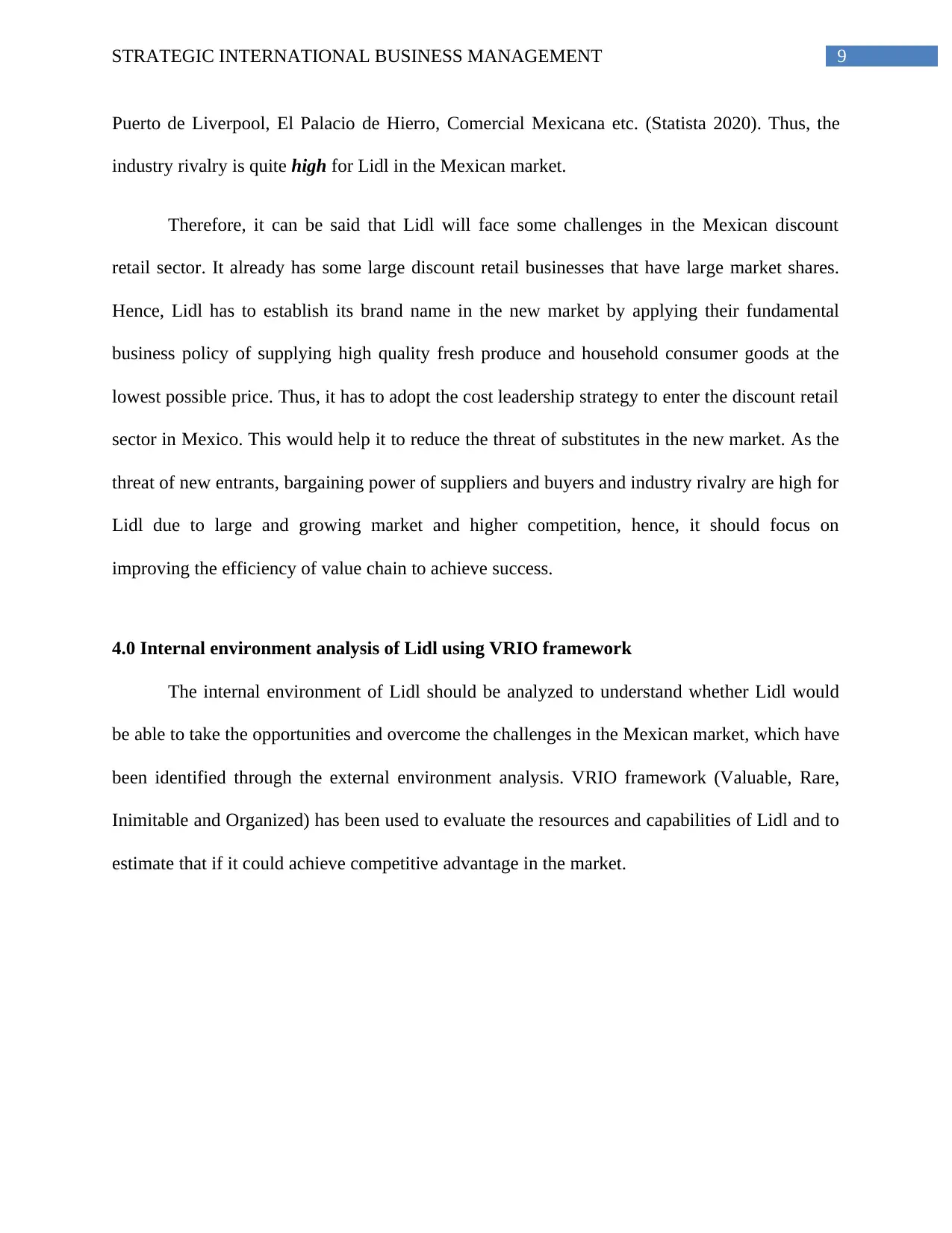
9STRATEGIC INTERNATIONAL BUSINESS MANAGEMENT
Puerto de Liverpool, El Palacio de Hierro, Comercial Mexicana etc. (Statista 2020). Thus, the
industry rivalry is quite high for Lidl in the Mexican market.
Therefore, it can be said that Lidl will face some challenges in the Mexican discount
retail sector. It already has some large discount retail businesses that have large market shares.
Hence, Lidl has to establish its brand name in the new market by applying their fundamental
business policy of supplying high quality fresh produce and household consumer goods at the
lowest possible price. Thus, it has to adopt the cost leadership strategy to enter the discount retail
sector in Mexico. This would help it to reduce the threat of substitutes in the new market. As the
threat of new entrants, bargaining power of suppliers and buyers and industry rivalry are high for
Lidl due to large and growing market and higher competition, hence, it should focus on
improving the efficiency of value chain to achieve success.
4.0 Internal environment analysis of Lidl using VRIO framework
The internal environment of Lidl should be analyzed to understand whether Lidl would
be able to take the opportunities and overcome the challenges in the Mexican market, which have
been identified through the external environment analysis. VRIO framework (Valuable, Rare,
Inimitable and Organized) has been used to evaluate the resources and capabilities of Lidl and to
estimate that if it could achieve competitive advantage in the market.
Puerto de Liverpool, El Palacio de Hierro, Comercial Mexicana etc. (Statista 2020). Thus, the
industry rivalry is quite high for Lidl in the Mexican market.
Therefore, it can be said that Lidl will face some challenges in the Mexican discount
retail sector. It already has some large discount retail businesses that have large market shares.
Hence, Lidl has to establish its brand name in the new market by applying their fundamental
business policy of supplying high quality fresh produce and household consumer goods at the
lowest possible price. Thus, it has to adopt the cost leadership strategy to enter the discount retail
sector in Mexico. This would help it to reduce the threat of substitutes in the new market. As the
threat of new entrants, bargaining power of suppliers and buyers and industry rivalry are high for
Lidl due to large and growing market and higher competition, hence, it should focus on
improving the efficiency of value chain to achieve success.
4.0 Internal environment analysis of Lidl using VRIO framework
The internal environment of Lidl should be analyzed to understand whether Lidl would
be able to take the opportunities and overcome the challenges in the Mexican market, which have
been identified through the external environment analysis. VRIO framework (Valuable, Rare,
Inimitable and Organized) has been used to evaluate the resources and capabilities of Lidl and to
estimate that if it could achieve competitive advantage in the market.
Paraphrase This Document
Need a fresh take? Get an instant paraphrase of this document with our AI Paraphraser
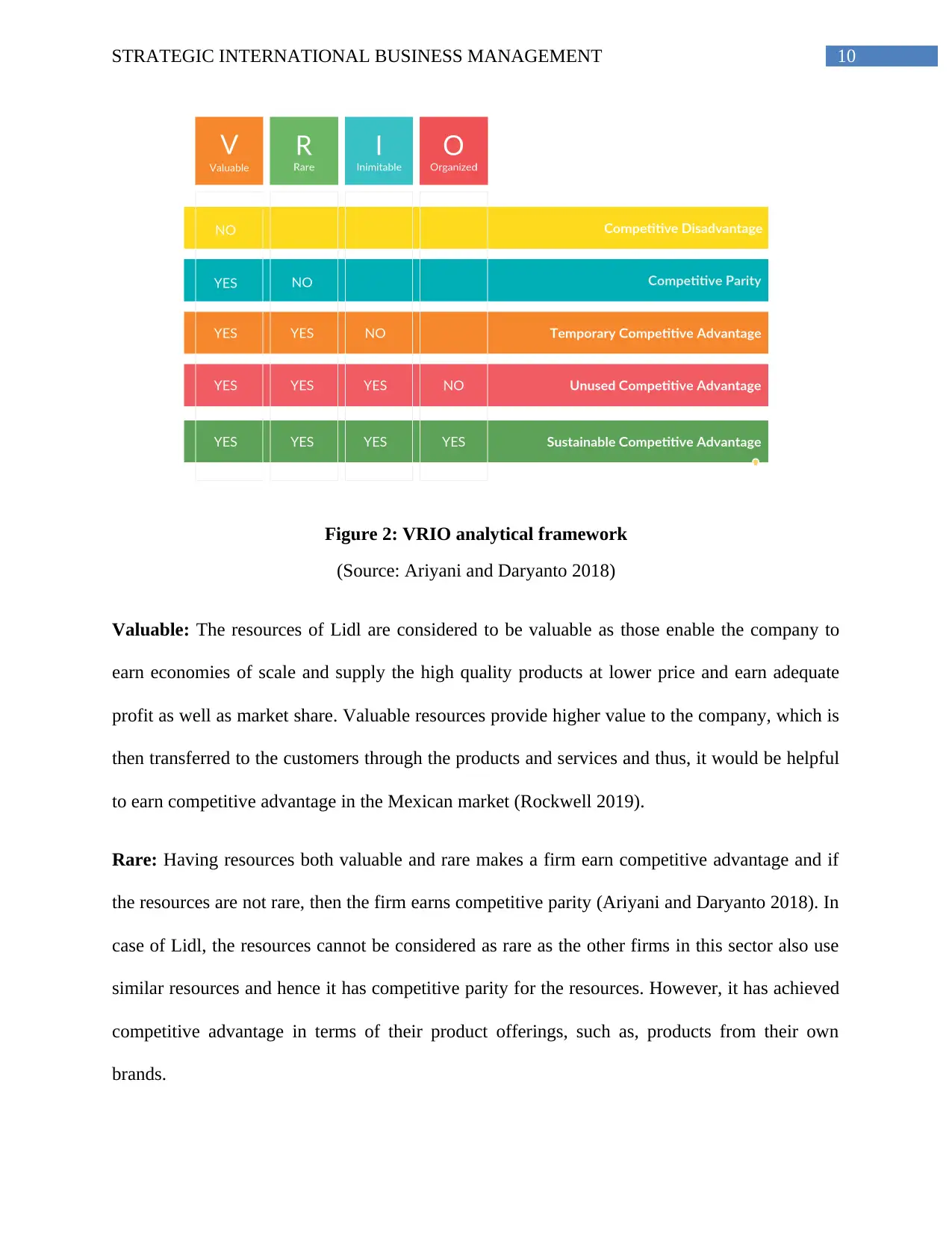
10STRATEGIC INTERNATIONAL BUSINESS MANAGEMENT
Figure 2: VRIO analytical framework
(Source: Ariyani and Daryanto 2018)
Valuable: The resources of Lidl are considered to be valuable as those enable the company to
earn economies of scale and supply the high quality products at lower price and earn adequate
profit as well as market share. Valuable resources provide higher value to the company, which is
then transferred to the customers through the products and services and thus, it would be helpful
to earn competitive advantage in the Mexican market (Rockwell 2019).
Rare: Having resources both valuable and rare makes a firm earn competitive advantage and if
the resources are not rare, then the firm earns competitive parity (Ariyani and Daryanto 2018). In
case of Lidl, the resources cannot be considered as rare as the other firms in this sector also use
similar resources and hence it has competitive parity for the resources. However, it has achieved
competitive advantage in terms of their product offerings, such as, products from their own
brands.
Figure 2: VRIO analytical framework
(Source: Ariyani and Daryanto 2018)
Valuable: The resources of Lidl are considered to be valuable as those enable the company to
earn economies of scale and supply the high quality products at lower price and earn adequate
profit as well as market share. Valuable resources provide higher value to the company, which is
then transferred to the customers through the products and services and thus, it would be helpful
to earn competitive advantage in the Mexican market (Rockwell 2019).
Rare: Having resources both valuable and rare makes a firm earn competitive advantage and if
the resources are not rare, then the firm earns competitive parity (Ariyani and Daryanto 2018). In
case of Lidl, the resources cannot be considered as rare as the other firms in this sector also use
similar resources and hence it has competitive parity for the resources. However, it has achieved
competitive advantage in terms of their product offerings, such as, products from their own
brands.
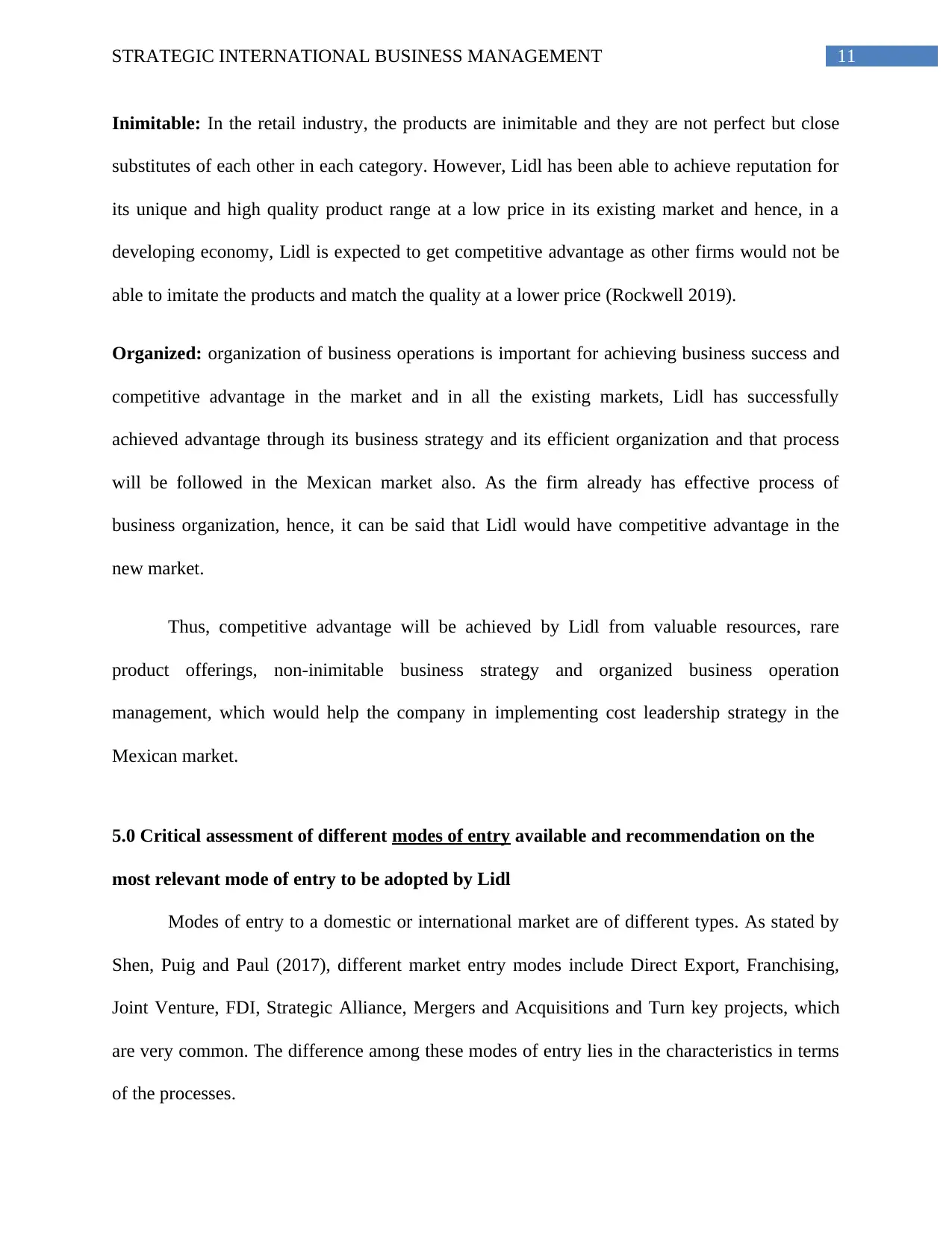
11STRATEGIC INTERNATIONAL BUSINESS MANAGEMENT
Inimitable: In the retail industry, the products are inimitable and they are not perfect but close
substitutes of each other in each category. However, Lidl has been able to achieve reputation for
its unique and high quality product range at a low price in its existing market and hence, in a
developing economy, Lidl is expected to get competitive advantage as other firms would not be
able to imitate the products and match the quality at a lower price (Rockwell 2019).
Organized: organization of business operations is important for achieving business success and
competitive advantage in the market and in all the existing markets, Lidl has successfully
achieved advantage through its business strategy and its efficient organization and that process
will be followed in the Mexican market also. As the firm already has effective process of
business organization, hence, it can be said that Lidl would have competitive advantage in the
new market.
Thus, competitive advantage will be achieved by Lidl from valuable resources, rare
product offerings, non-inimitable business strategy and organized business operation
management, which would help the company in implementing cost leadership strategy in the
Mexican market.
5.0 Critical assessment of different modes of entry available and recommendation on the
most relevant mode of entry to be adopted by Lidl
Modes of entry to a domestic or international market are of different types. As stated by
Shen, Puig and Paul (2017), different market entry modes include Direct Export, Franchising,
Joint Venture, FDI, Strategic Alliance, Mergers and Acquisitions and Turn key projects, which
are very common. The difference among these modes of entry lies in the characteristics in terms
of the processes.
Inimitable: In the retail industry, the products are inimitable and they are not perfect but close
substitutes of each other in each category. However, Lidl has been able to achieve reputation for
its unique and high quality product range at a low price in its existing market and hence, in a
developing economy, Lidl is expected to get competitive advantage as other firms would not be
able to imitate the products and match the quality at a lower price (Rockwell 2019).
Organized: organization of business operations is important for achieving business success and
competitive advantage in the market and in all the existing markets, Lidl has successfully
achieved advantage through its business strategy and its efficient organization and that process
will be followed in the Mexican market also. As the firm already has effective process of
business organization, hence, it can be said that Lidl would have competitive advantage in the
new market.
Thus, competitive advantage will be achieved by Lidl from valuable resources, rare
product offerings, non-inimitable business strategy and organized business operation
management, which would help the company in implementing cost leadership strategy in the
Mexican market.
5.0 Critical assessment of different modes of entry available and recommendation on the
most relevant mode of entry to be adopted by Lidl
Modes of entry to a domestic or international market are of different types. As stated by
Shen, Puig and Paul (2017), different market entry modes include Direct Export, Franchising,
Joint Venture, FDI, Strategic Alliance, Mergers and Acquisitions and Turn key projects, which
are very common. The difference among these modes of entry lies in the characteristics in terms
of the processes.
⊘ This is a preview!⊘
Do you want full access?
Subscribe today to unlock all pages.

Trusted by 1+ million students worldwide
1 out of 22
Related Documents
Your All-in-One AI-Powered Toolkit for Academic Success.
+13062052269
info@desklib.com
Available 24*7 on WhatsApp / Email
![[object Object]](/_next/static/media/star-bottom.7253800d.svg)
Unlock your academic potential
Copyright © 2020–2025 A2Z Services. All Rights Reserved. Developed and managed by ZUCOL.





